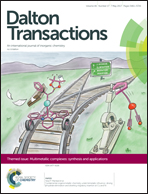Monodentate phosphine substitution in [Pd(κ3-dppf)(PR3)][BF4]2 (dppf = 1,1′-bis(diphenylphosphino)ferrocene) compounds†
Abstract
The ligand 1,1′-bis(diphenylphosphino)ferrocene (dppf) is commonly employed in a variety of catalytic systems. There are a variety of coordination modes known for dppf, the least studied being the κ3 coordination mode, in which both phosphorus atoms and the iron atom of dppf interact with another metal center. One such compound is the previously reported [Pd(κ3-dppf)(PPh3)]2+. A series of related compounds, [Pd(κ3-dppf)(P(p-C6H4R)3)]2+ (R = OCH3, CH3, F and CF3), has been synthesized and characterized. The X-ray crystal structure of [Pd(dppf)(P(p-C6H4F)3)][BF4]2 was determined. Electrochemical and computational studies indicate that the electron donor ability of the P(p-C6H4R)3 ligands influences the properties of these compounds. Substitution reactions of the P(p-C6H4R)3 ligands have been examined, and, in general, the more electron donating P(p-C6H4R)3 ligands completely replace the less electron donating ones. The kinetics of the reaction of [Pd(κ3-dppf)(P(p-C6H4F)3)]2+ with P(p-C6H4OCH3)3 indicate that the reaction proceeds through a dissociative mechanism, contrary to the associative substitutions prevalent in square planar palladium(II) chemistry.
![Graphical abstract: Monodentate phosphine substitution in [Pd(κ3-dppf)(PR3)][BF4]2 (dppf = 1,1′-bis(diphenylphosphino)ferrocene) compounds](/en/Image/Get?imageInfo.ImageType=GA&imageInfo.ImageIdentifier.ManuscriptID=C6DT04921D&imageInfo.ImageIdentifier.Year=2017)
- This article is part of the themed collection: Multimetallic complexes: synthesis and applications


 Please wait while we load your content...
Please wait while we load your content...